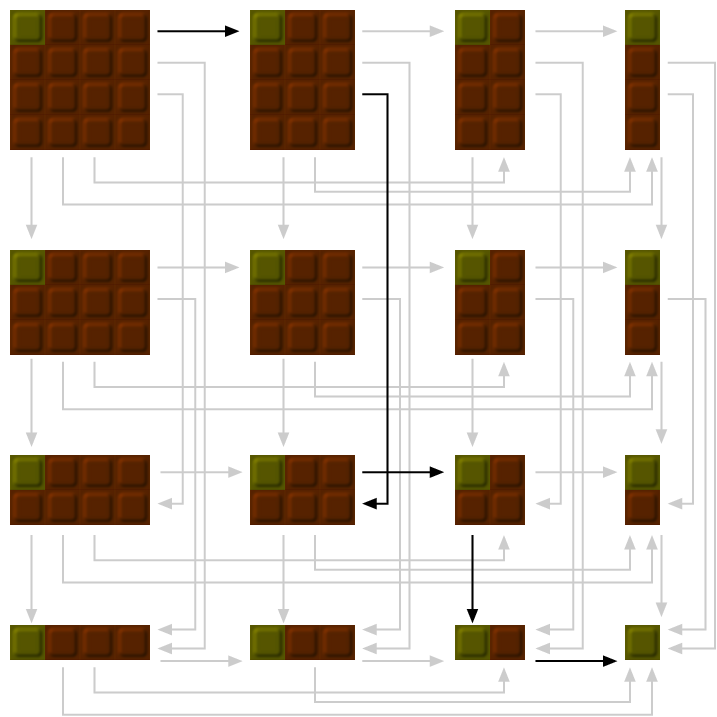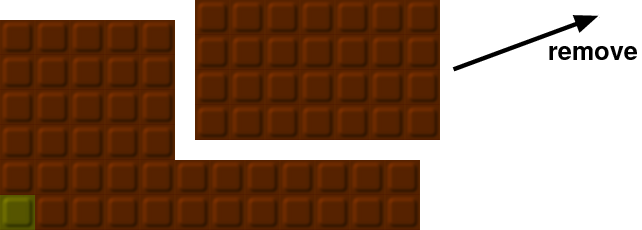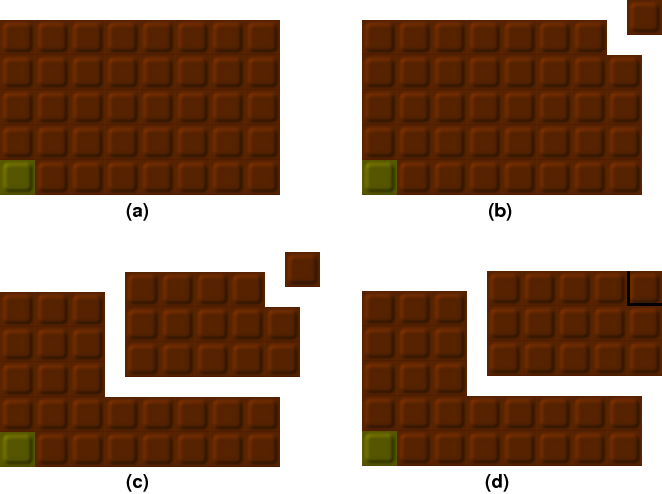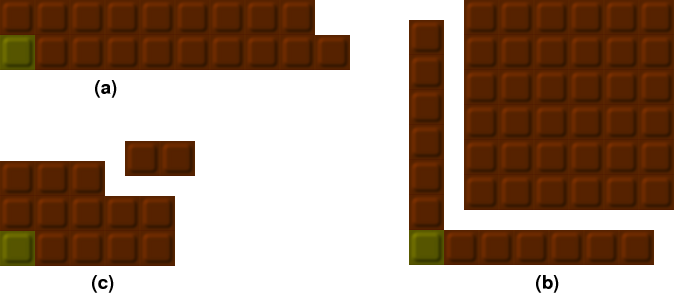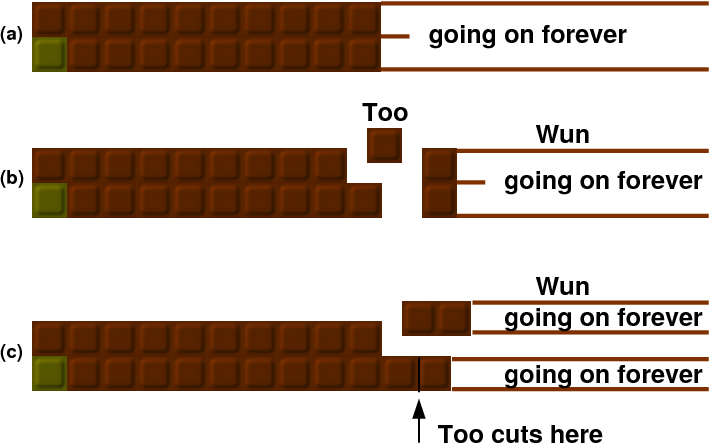 |
 |
|
||
|
|
||||
|
Choosily Chomping Chocolate MATHEMATICAL RECREATIONS by Ian Stewart Scientific American, October 1998 Just because a game has simple rules, that doesn't imply that there must be a simple strategy for winning it. Sometimes there is — tic-tac-toe is a good example. But sometimes there isn't — another childhood game, "boxes," in which players take turns to fill in edges on a grid of dots and capture any square they complete, is a case in point. I call the first kind "dream games" and the others "nightmare games," for fairly obvious reasons. Games with very similar rules can be surprisingly different when it comes to their dream or nightmare status. And, of course, the nightmare games are often the most interesting, because you can play them without knowing in advance who ought to win — or, in some cases, knowing who ought to win but not knowing how they can do it. As an illustration of these surprising facts, I'm going to discuss two games based around chocolate bars. One, "yucky choccy," is a dream game. The other, "chomp," has very similar rules, but it's a nightmare game — with the startling extra ingredient that with optimal play the first player should always win, but nobody knows how. I have no idea who invented yucky choccy: it was explained to me by Keith Austin, a British mathematician at Sheffield University. It takes place on an idealised chocolate bar, a rectangle divided into smaller squares. Players — I'll name them "Wun" and "Too" after the order in which they play — take turns to break off a lump of chocolate, which they must eat. Call this action a move in the game. The break must be a single straight line cutting all the way across the rectangle along the lines between the squares. The square in one corner contains a lump of soap, and the player who has to eat this square loses. The black arrows in Figure 1 show the moves in the game played with a 4 \times 4 bar, and the grey arrows show all the other moves that could have been made instead.
This entire diagram constitutes the game tree for 4 \times 4 yucky choccy. As we'll shortly see, Too made a bad mistake and lost a game that should have been won. A winning strategy is a sequence of moves that forces a win, no matter what moves the opponent makes. The concept of a strategy involves not just one game, but all possible games. When you play chess, most of your planning centres on "what if" questions. "If I advance my pawn, what could his queen do then?" Tactics and strategy centre around what moves you or your opponent could make in future, not just the moves that they do make. There is a neat theory of strategies for "finite" games — ones that can't continue forever and in which draws are impossible. It relies on two simple principles:
The logic here may seem circular, but it's not: it's recursive. The difference is that with recursive reasoning you have a place to start. To see how, I'll use the above two principles to find a winning strategy for 4 \times 4 yucky choccy. The trick is to start from the end and work backwards, a process called "pruning the game tree." The single soapy piece
whose entries refer not to a chocolate bar, but to
the the various positions marked in Figure 1. Here L means "losing position," *
means "don't know yet," and "W" will mean "winning position" once I've
found some. In fact,
What about
This in turn implies that
working backwards in this manner you can eventually deduce the win/lose status of any position. The logic runs not in circles, but in interlocking spirals, climbing down the game tree from leaf to twig, from twig to branch, from branch to limb... Hence the "pruning" image. We have to start from the end, though, which is a nuisance. What we really want to do is chop down the entire game tree in one blow, George Washington fashion, to find the status of the opening position — and if it's a winner, to find what move to play. For games with a small tree there's no difficulty: repeated pruning yields the status of all positions. In Figure 1 we can carry this out, to get
So the 4 \times 4 position, for instance, is a loser. If you try larger bars of chocolate, square or
rectagular, you'll quickly find that the same pattern emerges: losers
live along the diagonal line, all other bars are winners. Now the bars
on that diagonal are the square ones: 1 \times
1, 2 \times 2, 3
\times 3, 4 \times 4. This suggests a
simple strategy that should apply to bars of any size: squares are
losers, rectangles are winners. Having noticed this apparent pattern,
we can check its validity without working through the entire
game tree by verifying properties 1 and 2. Here's the
reasoning. Clearly any rectangle (winner) can always be converted to a
square (loser) in one move. In contrast, whatever move you make
starting with a square (loser), you cannot avoid leaving your opponent
a rectangle (winner). Moreover,
In principle the same procedure applies to any finite game. The opening position is the "root" of the game tree. At the other extreme are the tips of the outermost twigs, which terminate at positions where one or other player has won. Since we know the win/lose status of these terminal positions, we can work backwards along the branches of the game tree using principles 1 and 2, labelling positions "win" or "lose" as we proceed. The first time, we determine the status of all positions that are one move away from the end of the game. The next time, we determine the status of all positions that are two moves away from the end of the game, and so on. Since, by assumption, the game tree is finite, eventually we reach the root of the tree — the opening position. If this gets the label "win" then Wun has a winning strategy; if not, Too has. We can even say, again in principle, what the winning strategy is. If the opening position is "win" then Wun should always move to a position labelled "lose" — which Too will then face. Because this is a losing position, any move Too makes presents Wun with a "win" position. So Wun can repeat the same strategy until the game ends. Similarly, if the opening position is labelled "lose," then Too has a winning strategy — with the same description. So in finite, drawless games, working backwards through the game tree in principle decides the status of all positions, including the opening one. I say "in principle" because the calculations become intractable if the game tree is large. And even simple games can have huge game trees, because the game tree involves all possible positions and all possible lines of play. This opens the door to nightmare games. We now contrast yucky choccy with a game whose rules are almost the same, but where pruning the game tree rapidly becomes impossible — and where pruning is possible, it does not reveal any pattern that could lead to a simple strategic recipe. That game is chomp, invented many years ago by David Gale (U of California at Berkeley) and described in his marvellous new book on recreational mathematics, Tracking the Automatic Ant (Springer-Verlag, New York, 1998). Gale describes chomp using a rectangular array of cookies, but I'll stick to chocolate. (It is best played with an array of buttons or the like.) Chomp is just like yucky choccy, with the sole difference that a legitimate move consists of removing a rectangular chunk of chocolate, as in Figure 2.
Specifically, a player chooses a component square and then removes all squares above it in that column and all squares to the right of it in that row, together with all squares above and to the right of these. There is a neat proof that for any size of bar (Figure 3a) other than 1x1, chomp is a win for Wun. Suppose, to the contrary, that Too has a winning strategy. Wun then proceeds by removing the upper right square (Figure 3b). This cannot leave Too facing a losing position, since we are assuming the opening position is a loser for Wun. So Too can play a winning move, something like Figure 3c, to leave Wun facing a loser. But then Wun could have played Figure 3d, leaving Too facing the same loser. This contradicts the assumption that Too has a winning strategy, so that assumption must be false. Therefore, Wun has a winning strategy.
Proofs of this kind are called "strategy stealing." If Wun can make a "dummy" move, pretend to be the second player, and win by following what ought to be a winning strategy for Too, then Too could not have had such a strategy to begin with — implying that Wun must have a winning strategy. The irony of this method of proof, when it works, is that it offers no clue to what Wun's winning strategy should be! For chomp, detailed winning strategies are unknown, except in a few simple cases. In the 2 \times n (or n \times 2) case, Wun can always ensure that Too faces a position that is a rectangle minus a single corner square (Figure 4a). In the n \times n case, Wun removes everything except an L-shaped edge (Figure 4b), and after that copies whatever move Too makes, but reflected in the diagonal. A few other small cases are known: for example in 3 \times 5 chomp the sole winning move for Wun is Figure 4c. "The" winning move need not be unique: in the 6 \times 13 game there are two different winning moves.
Other information about chomp positions can be found on page 598 of Winning Ways by Elwyn R. Berlekamp, John H. Conway, and Richard K. Guy (Academic Press, New York 1982). Chomp can also be played with an infinite chocolate bar — in which case, paradoxically, it remains a finite game because after finitely many moves only a finite portion of bar remains. But there is a change: Too can sometimes win. This happens, for example, with the 2 \times \infty bar. Figure 5 shows that whatever Wun does, Too can choose a reply that leads to Figure 4a, which we already know is a loser.
Strictly speaking, I should be more careful here. By "\infty" I really mean the set of positive integers in their usual order, which set theorists symbolise as \omega ("omega") and refer to as "the first infinite ordinal." There are many other infinite ordinals, but their properties are too technical to describe here: see Gale's book for further details. Chomp can be played on doubly infinite arrays of ordinals, or in three or more dimensions: on the whole, little is known about winning strategies for these generalisations. | ||||||||||||||||||||||||||||||||||||||||||||||||||||||||||||||||||||||||||||||||||||||||||||||||||||||||

